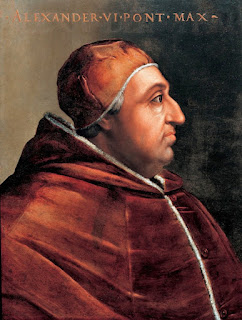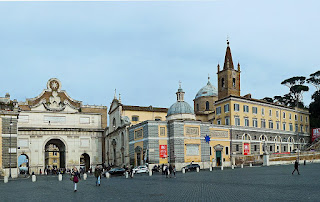Writer rose to become a duke but died in poverty
,_RP-P-1909-4600.jpg) |
| Bernardo Accolti became one of the most popular love poets of the Renaissance |
Referred to as ‘Unico Aretino’ because of his noble origins and his ability to express himself in verse, Accolti lived at many of the Italian courts and had platonic relationships with some of the most important noblewomen of his time, including Lucrezia Borgia, Isabella d’Este and Elisabetta Gonzaga.
Although born into a noble family, Accolti always had ambitions to acquire more social status for himself, and he eventually managed to accumulate enough money to purchase a Duchy to rule over.
While he was growing up, Accolti had lived with his family in Florence, where he received a humanist education. After moving to Rome when he was a young man, he started writing poetry.
One of his most well-known works, which has survived to this day, is his comedy in verse, Virginia, which was based on a story from Boccaccio’s Decameron and was composed for a wedding in Siena.
But the poet was then exiled from Florence for reasons that are not known and so he returned to Rome, where he was given work as a writer of papal bulls by Pope Alexander VI.
After receiving a pardon by Florence, he returned to the city, but he was exiled again in 1497. Always loyal to the Medici, he was accused of financing the attempt made by Piero Il Fatuo to conquer the city.
Accolti had lent him 200 florins to carry out a plot against Girolamo Savanorala, who was then head of the Florentine Republic. The main conspirators were caught and beheaded and Accolti was exiled permanently.
.png) |
| The painter Raphael painted Accolti as one of the figures in his Parnassus fresco |
Accolti travelled to Milan, Mantua, Urbino, and Naples, where he would sing his own verses and accompany them on the lute, or lira da braccio, a Renaissance stringed instrument.
He had close relationships with many of the noble ladies he encountered, but it is thought his true love was revealed in his verses to Elisabetta Gonzaga, Duchess of Urbino. He also dedicated two sonnets to Lucrezia Borgia, but there is no evidence that he was ever her lover.
After Giovanni de’ Medici became Pope Leo X in 1513, Accolti was given high office because of his previous loyalty to the Medici family.
The first printed editions of his works were published at this time, Virginia in 1512, and a few years later, a collection of his verses.
By then he had amassed enough wealth to buy the Duchy of Nepi from the Pope, an ancient city now in the province of Viterbo in Lazio. He moved into the fortress that had been built there by the Borgias and he built a new residential wing on to it with a motto over the entrance.
But he proved to be a poor administrator and sometimes took violent reprisals against people who opposed him in the Duchy. In 1523, there was a revolt against him by the locals but he managed to suppress it with the help of the Pope’s Swiss Guards.
After being expelled from Nepi three times, Accolti was unable to gather the funds to reconquer it for a fourth time.
Pope Paul III, who had been his protector until then, revoked his title of Duke, as he was intending to give the Duchy to his own illegitimate son. Nepi was later incorporated into the Duchy of Castro.
Accolti returned to Rome, poor and desperate He died there in February 1535, leaving two illegitimate children, Alfonso Maria and Virginia.
A definitive collection of his work was published in Venice by Nicolo d’Aristotele in 1530 and it was reprinted in the year of Accolti’s death.
In 1996, a full collection of his verses was published, which included 58 previously unpublished poems that had been kept in the Vatican archives.
Accolti appears as a character in some passages of Baldassare Castiglione’s The Book of the Courtier, and he was a close friend of Pietro Aretino, who was also a poet from Arezzo.
 |
| The beautiful Piazza Grande in Arezzo, the sloping square, paved in red brick, at the heart of the city |
Arezzo is one of the wealthiest cities in Tuscany. Despite its medieval centre suffering massive damage during the Second World War, targeted for its strategic importance on the Italian rail network, many monuments, churches and museums survived or were reconstructed. Its main sights include the Basilica di San Francesco, with its beautiful History of the True Cross fresco cycle by Piero della Francesca, the central Piazza Grande, with its sloping pavement in red brick, the Medici Fortress, the duomo and a Roman amphitheatre. The original duomo was built on the nearby Pionta Hill, over the burial place of Donatus of Arezzo, who was martyred in 363. In 1203 Pope Innocent III had the cathedral moved within the city's walls, to the current site in another elevated position a short walk from Piazza Grande. The construction of the current structure started in 1278 and continued in phases until 1511, although the façade visible today, designed by Dante Viviani, was not completed until 1914, replacing one left unfinished in the 15th century. The interior contains several notable artworks, including a relief by Donatello, entitled Baptism of Christ, and a cenotaph to Guido Tarlati, lord of Arezzo until 1327, said to be designed by Giotto, near to which is Piero della Francesca's Mary Magdalene.
Search hotels in Arezzo
 |
| The Rocca - or Castello Borgia - casts an imposing shadow over the town of Nepi in northern Lazio |
Nepi, the town that Accolti acquired when he bought the Duchy of Nepi, can be found 50km (31 miles) north of Rome, about 20km (12.4 miles) from Lago Bracciano. It is in the area known as ancient Etruria, having been a pre-Roman settlement before the Romans arrived and established a stronghold in 383 BC and eventually conquered the entire region. Throughout the Renaissance era, it was the feudal domain of the noble families of Lazio and passed successively from the Orsini to the Colonna and then the Borgia. The Rocca - the 15th-century Borgia Castle that was once the property of Lucrezia Borgia - dominates the skyline making it an imposing presence. Accolti's coat of arms was discovered in a residential extension of the castle, dating it between September 1521 and the beginning of 1535. A graceful monumental aqueduct looks Roman but was built in more recent history to carry spring water. Acqua di Nepi mineral water is bottled and distributed nationwide. The ancient Porta Roman was the main gate, and is still the primary entry to the historic centre. Other attractions include the Palazzo Comunale, a Renaissance style villa built by Sangallo the Younger for Duke Pier Luigi Farnese, which has in front of it a fountain presumed to have been the world of Gian Lorenzo Bernini.
Find hotels in Nepi
Also on this day:
1522: The birth of naturalist Ulisse Aldrovandi
1871: The birth of adventurer Scipione Borghese
1920: The birth of partisan Manrico Ducceschi






.jpg)

.jpg)
























